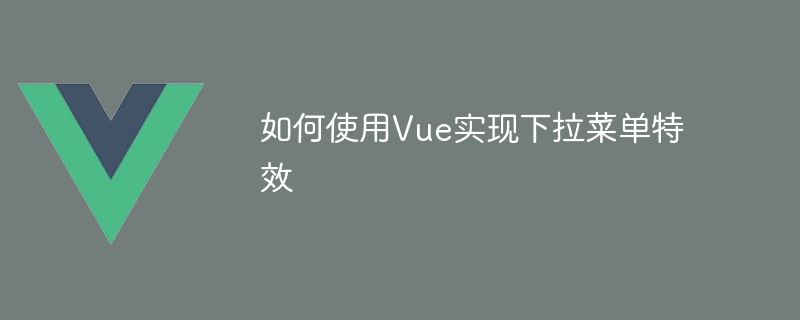

How to use Vue to implement drop-down menu effects
Introduction:
The drop-down menu is one of the common interactive components in web design. It can make the web page more beautiful and The function is more powerful. As a popular JavaScript framework, Vue provides a convenient component-based development method, which can easily implement drop-down menu effects. This article will use a simple example to introduce how to use Vue to implement a drop-down menu.
1. HTML structure:
The HTML structure of the drop-down menu is very simple. It usually consists of a trigger button and a menu list. First, we need to define the structure of the drop-down menu in HTML.
<div id="app">
<button @click="toggleMenu">下拉菜单</button>
<ul v-if="isOpen" @click="selectItem">
<li>菜单项1</li>
<li>菜单项2</li>
<li>菜单项3</li>
</ul>
</div>In the above code, we define a Vue root element with the id "app", and define a button and a ul element in it to display menu items. The key here is to use Vue's instructions v-if and v-on to achieve dynamic rendering and event binding.
2. Vue instance:
Next, we need to create a Vue instance in JavaScript to control the display and hiding of the drop-down menu.
new Vue({
el: '#app',
data: {
isOpen: false
},
methods: {
toggleMenu() {
this.isOpen = !this.isOpen;
},
selectItem() {
this.isOpen = false; // 点击菜单项后关闭下拉菜单
}
}
});In the above code, we create a Vue instance and define the isOpen property in the data option to control the display and hiding of the menu. Then, two methods, toggleMenu and selectItem, are defined in the methods option, which are used to switch the display of the menu and close the menu.
3. CSS style:
In order to make the drop-down menu have better visual effects, we need to set some styles for it in CSS.
ul {
display: none;
background-color: #f0f0f0;
padding: 10px;
position: absolute;
top: 40px;
left: 0;
width: 100px;
border: 1px solid #ccc;
}
ul li {
list-style: none;
margin-bottom: 5px;
cursor: pointer;
}
button:focus + ul {
display: block;
}In the above code, we defined some basic styles for the ul element, such as background color, border, width, etc., and used the position attribute to position it below the button. Then, styles are set for the li element, such as removing the default list style and adding mouse pointer style. Finally, by using the :focus selector in CSS, the effect of displaying the menu when the button gets focus is achieved.
Summary:
Through the above steps, we successfully implemented a simple drop-down menu effect using Vue. Through Vue's command and event binding functions, we can easily control the display and hiding of the menu, and give it better visual effects through CSS styles. Of course, according to actual needs, we can also add more functions and styles to expand and customize the drop-down menu.
The above are the detailed steps on how to use Vue to implement drop-down menu effects. I hope it will be helpful to you! If you have more needs, you are welcome to continue exploring in Vue’s official documentation and related resources. Good luck writing better drop-down menus!
The above is the detailed content of How to use Vue to implement drop-down menu effects. For more information, please follow other related articles on the PHP Chinese website!




